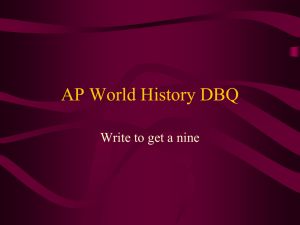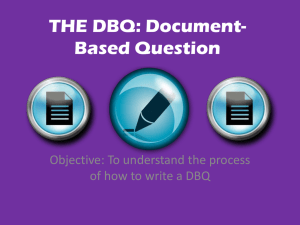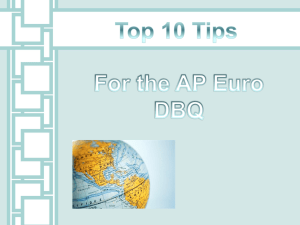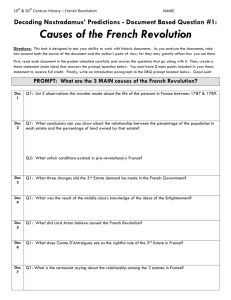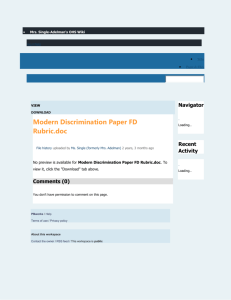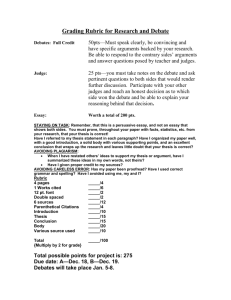2006 Annotated DBQ Rubric: Global Silver Trade Effects Angela Lee
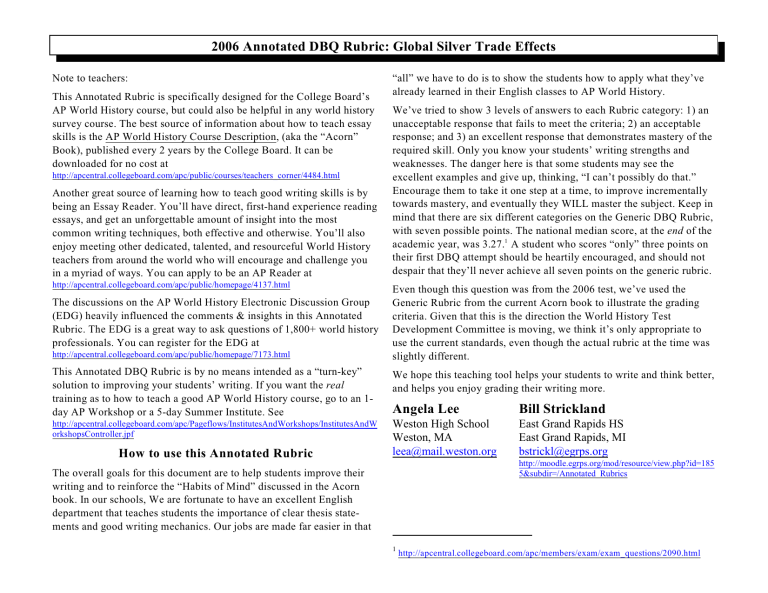
2006 Annotated DBQ Rubric: Global Silver Trade Effects
Note to teachers:
This Annotated Rubric is specifically designed for the College Board’s
AP World History course, but could also be helpful in any world history survey course. The best source of information about how to teach essay skills is the AP World History Course Description, (aka the “Acorn”
Book), published every 2 years by the College Board. It can be downloaded for no cost at http://apcentral.collegeboard.com/apc/public/courses/teachers_corner/4484.html
Another great source of learning how to teach good writing skills is by being an Essay Reader. You’ll have direct, first-hand experience reading essays, and get an unforgettable amount of insight into the most common writing techniques, both effective and otherwise. You’ll also enjoy meeting other dedicated, talented, and resourceful World History teachers from around the world who will encourage and challenge you in a myriad of ways. You can apply to be an AP Reader at http://apcentral.collegeboard.com/apc/public/homepage/4137.html
The discussions on the AP World History Electronic Discussion Group
(EDG) heavily influenced the comments & insights in this Annotated
Rubric. The EDG is a great way to ask questions of 1,800+ world history professionals. You can register for the EDG at http://apcentral.collegeboard.com/apc/public/homepage/7173.html
This Annotated DBQ Rubric is by no means intended as a “turn-key” solution to improving your students’ writing. If you want the real training as to how to teach a good AP World History course, go to an 1day AP Workshop or a 5-day Summer Institute. See http://apcentral.collegeboard.com/apc/Pageflows/InstitutesAndWorkshops/InstitutesAndW orkshopsController.jpf
How to use this Annotated Rubric
The overall goals for this document are to help students improve their writing and to reinforce the “Habits of Mind” discussed in the Acorn book. In our schools, We are fortunate to have an excellent English department that teaches students the importance of clear thesis statements and good writing mechanics. Our jobs are made far easier in that
“all” we have to do is to show the students how to apply what they’ve already learned in their English classes to AP World History.
We’ve tried to show 3 levels of answers to each Rubric category: 1) an unacceptable response that fails to meet the criteria; 2) an acceptable response; and 3) an excellent response that demonstrates mastery of the required skill. Only you know your students’ writing strengths and weaknesses. The danger here is that some students may see the excellent examples and give up, thinking, “I can’t possibly do that.”
Encourage them to take it one step at a time, to improve incrementally towards mastery, and eventually they WILL master the subject. Keep in mind that there are six different categories on the Generic DBQ Rubric, with seven possible points. The national median score, at the end of the their first DBQ attempt should be heartily encouraged, and should not despair that they’ll never achieve all seven points on the generic rubric.
Even though this question was from the 2006 test, we’ve used the
Generic Rubric from the current Acorn book to illustrate the grading criteria. Given that this is the direction the World History Test
Development Committee is moving, we think it’s only appropriate to use the current standards, even though the actual rubric at the time was slightly different.
We hope this teaching tool helps your students to write and think better, and helps you enjoy grading their writing more.
Angela Lee
Weston High School
Bill Strickland
East Grand Rapids HS
Weston, MA East Grand Rapids, MI leea@mail.weston.org
bstrickl@egrps.org
http://moodle.egrps.org/mod/resource/view.php?id=185
5&subdir=/Annotated_Rubrics
1 http://apcentral.collegeboard.com/apc/members/exam/exam_questions/2090.html
2006 Annotated DBQ Rubric: Global Silver Trade Effects
Question: Using the documents, analyze the social and economic effects of the global flow of silver from the mid-sixteenth century to the early eighteenth century. Explain how another type of document would help you analyze the effects of the flow of silver bullion in this period.
Historical Background: Spanish colonial America and Tokugawa Japan led the world in silver production from 1500 to
1750. In the early 1570's, the Ming Chinese government required that all domestic taxes and trade fees be paid in silver.
Point #
Question
Historical
Background
(Also included was a map entitled “The Primary Flow of Silver, 1570-1750)
Official Description
Commentary
Examples
and
Commentary
To answer this question fully, the answer needed to address the social AND economic effects of the flow of silver and to qualify the effects in some manner since the question is asking for an analysis of the effects. See notes on Thesis.
The Issues Although the historical background included references to the imposition of taxes and fees that were required in China, if students used this piece of information, they were given credit for Document 3 which reflected the same Chinese regulation.
This is the first time a World History DBQ included a map. The map was at times used erroneously as a document. Even with the map, some students mistook Ming China as
Japanese, and treated the Philippines as an independent state rather than a colony of Spain.
1
2 2006 Annotated DBQ Rubric: Global Silver Trade Effects
Point #
1
Thesis
Official Description
Commentary
Examples
and
Commentary
Has acceptable thesis.
• Must be explicitly stated in the introduction or conclusion of the essay.
• May appear as 1 sentence or 2 or more contiguous sentences.
• May not be split
• May not be a mere restatement of the question.
• Must address the social and economic effects of the global flow of silver as indicated in the doc’s.
The Thesis Should:
3. Set out categories for discussion
2
1. Address all parts of the question
2. Take a position on the question
Unacceptable “There were many social and economic effects of the global trade in silver around the world.”
This thesis merely restates the question. “Many” is a virtually meaningless qualifier.
3
“The global silver trade had a large impact around the world.” Off topic. The question asks the reader to focus on the social and economic effects of the silver trade, NOT the amount of impact.
“During the years 1500 to 1750, silver production became very popular. Spanish colonial America and
Tokugawa Japan led the world in silver production.” The first sentence is off topic, while the second sentence is merely a restatement of the historical background. Not only would these < theses’ not earn the Thesis point on the DBQ Rubric, they might distract the author from earning other points (#3 Evidence, #5 Analysis by
Grouping). Make sure you answer precisely what the question asks.
Minimally Acceptable “The global silver trade from the mid-16 century to the early 18 century produced profound social changes in Spain, Ming China, Tokugawa Japan, England and the Netherlands and greatly reshaped the world economy.” This addresses both the social and economic effects of the silver trade, although it would help if the writer qualified them more.
Acceptable The flow of silver during the mid-16 century to the early 18 century had a great impact on the social and economic aspects of many countries through trade, effect on land and the value of silver.” Although not especially strong, this thesis shows the student understands the question, and has framed a response that lends itself to grouping in the body of the essay.
“The global flow of silver had many social and economic effects, such as increasing class distinctions in China and Europe, as well as hurting Spain’s economy.” This shows more specifics than the first one, making some distinction between the social and economic effects.
Excellent “The increased flow of silver during the mid-16 century to the early 18 century caused social and economic effects in all regions connected with the trade by increasing the integration of Europeans in the globalization of world trade and creating greater economic opportunities but also growing social divisions within China.” This thesis succinctly sums up the different social and economic effects facing different regions, and also previews the POV several documents will be analyzed by later in the essay. This thesis would likely be eligible for the “Expanded Core” as a “clear, analytical, comprehensive thesis.”
2
This advice is from the Social Studies Vertical teams guide book p. 140 and is directly generically at all thesis statements, not specifically this question.
3
I have a rule in my classroom, “Any thesis that contains the words ‘very,’ ‘many,’ ‘things,’ ‘lots,’ ‘stuff,’ or ‘ways’ is automatically vetoed.” Possibly the hardest skill to learn is the ability to form a sophisticated, complex thesis. One strategy I’ve learned (from Geri M cCarthy of Barrington, RI) is to require students to begin their thesis with“W hile”, “Although”, or “Despite/In spite of.” These words strongly encourage students to formulate a mature thesis that helps structure the rest of their essay. Once students can consistently write a competent thesis sentence, then I concentrate on having them develop an essay preview/outline of later paragraphs. The result should be a thesis paragraph that is several sentences long (the paragraph should NOT just be a single sentence).
2006 Annotated DBQ Rubric: Global Silver Trade Effects
Point #
2
Meaning
Official Description
Commentary
Addresses all of the documents and demonstrates understanding of all of all but one.
4
There are eight documents.
Students must address all documents in the essay and demonstrate understanding of the basic meaning in at least seven documents.
Listing the documents separately or listing the documents as part of a group does not sufficiently demonstrate an understanding of basic meaning.
Examples
and
Commentary
[Doc #6, Antonio Vazquez de Espinosa] “The ore at Potosi silver mine had so much silver in it that it has huge wealth. Ever since 1545 at the time of its discovery up to 1628 there has been a total of around 326,000,000 silver coins taken out. “ This quotation of Doc #6 shows limited understanding of the document. Although the student here may not have “demonstrated understanding” of this document, the essay did “address” this document. This is a key example of a student being able to gain the “evidence” point because they used only a part of the document to support an economic argument.
5
[Doc #2, Tomas de Mercado] “Because silver was of such value, countries such as Spain would get so much silver from China that the roads could be replaced with granite cobblestone to hold up all the silver. “ This is an obvious misinterpretation of Document 2 which reflects our current day POV of granite being “valuable.”
Acceptable There are a myriad of acceptable interpretations of doc’s. Readers take notes & familiarize themselves thoroughly with the documents. Suffice to say that readers will know a correct interpretation of a doc’s meaning when they see it. See following page for a short summary of each document.
Excellent Essay shows careful and insightful interpretation of the documents.
3
4
Note: This Rubric category has changed since this DBQ was administered. I have “retrofitted” it to reflect the current Rubric. Teachers should be careful to note that the while students can misinterpret the meaning of one document, they must at least attempt to interpret ALL documents. This Rubric Category requires two students to demonstrate two skills: 1) Acknowledge the existence of ALL relevant documents in their essay; and 2) Correctly interpret all or all but one of those documents. Students who correctly interpret all but one document but ignore the remaining document will not earn credit for this “M eaning” Rubric
Category.
5
Bard Keeler, 2006 DBQ Question Leader, EDG message entitled QL on the 2006 DBQ”, 6/22/2006: “Understanding the meaning of the documents and using the documents for evidence are two different skills, and it is possible to misunderstand a document but still draw accurate information from the document for evidence. Document 6 perhaps best illustrates this point as an essay may misunderstand the social effects described in the documents but still use evidence from the documents to accurately support an argument about economic effects.”
Document Summaries
Readers at the National Essay Reading were given a precís of each document’s relevant information and possible grouping that was most commonly used as evidence to support the thesis.
Doc #1 – Ye Chungji
Position: county official during the Ming Dynasty
Year: 1570’s
Ye Chungji noted the differences between the “frugal” and the
“extravagant” man in an order limiting wedding expenses.
Students often equated “frugal” w/ poor and “extravagant” w/ rich.
The doc is often connected with the other M ing sources represented in Docs 3, 5, and 7. “Frugal” in this doc and “venerable” in Doc #3 are sometimes used to analyze a
Confucian POV.
Doc #5 – Xu Dunqiu
Title: Essay in The Changing
Times
Position: Ming writer
Place: Hangzhou
Year: 1610
The author describes the change from a barter economy to a market economy as customers now
“receive a bill, which must paid with silver obtained from a moneylender.” The document is used to explain the decline of traditional Chinese society and economy and is grouped with
Docs 1 and 3.
Doc #2 – Tomas de Mercado
Title: Manual of Deals and Contracts
Position: Spanish scholar
Place: Seville Year: 1571
M ercado, in Seville, wrote about the trade from China to the Spanish Philippines. His indicated location sometimes triggers a POV analysis or a request for an additional doc.
Students often note the use of “ruined” at the beginning of the doc and pair it w/ Docs 3, 5 and 6, but the doc is most commonly paired w/ the European sources in Docs 4, 6, and 8.
Students often refer to granite cobblestones as luxury items exchanged for silver, which is a misread of the document.
Doc #6 – Antonio Vasquez de Espinosa
Title: Compendium and Description of the West Indies
Position: Spanish priest
Year: 1620
Espinosa described the impact of the silver trade on the “Indians” while providing general economic information. Students often not the negative effect of the silver trade on
Indians and sometimes group this document w/ Docs. 1,3, and 5 to demonstrate the social effects of the slave trade. An additional grouping includes Docs 4,7, and 8 regarding trade. Students attempting POV will generally use this document noting the views of a Spaniard, a priest, or more importantly a
Spanish priest. This POV is often cued by
Espinosa’s use of the term “poor fellows.”
Doc #3 – Wang Xijue
Title: report to the emperor
Position: Ming dynasty court official
Year: 1593
W ang Xijue attributed falling grain prices to the scarcity of silver in
China. The Chinese gov’t required that taxes be paid in silver, but the gov’t spends little of the silver that it collects. More broadly, the doc is used to explain the decline of traditional Chinese society and economy, and is grouped with Doc. 1 and 5.
“Venerable” in this doc and “frugal” in Doc. 1 are sometimes used to analyze a Confucian POV.
Doc #7 – He Qiaoyuan
Title: Report to Emperor on the possibility of repealing 1626 ban on foreign trade
Position: Ming dynasty court official
Year: 1630
He Qiaoyuan reported the inflated price of Chinese products in the
Philippines. Students will often connect the document to Docs. 4 and
8. The more sophisticated essays note that this document taken with the other M ing documents illustrates change-over-time in the sense of
China moving away from its traditional ideas about the economy and trade.
Doc #4 – Ralph Fitch
Title: An account of his travels to the East Indies
Position: British merchant
Year: 1599
Fitch described trade conducted by the
Portuguese between M acao and Japan noting that the Portuguese enjoyed a
“great advantage in China.” Students use the doc to describe the types of products traded or the amount of silver acquired in Japan. M ore sophisticated essays note the mercantilist tone of the doc regarding the Portuguese “great advantage.” It is often paired with docs
6,7, and 8.
Doc #8 – Charles D’Avenant
Title: “An Essay on the East-India
Trade”
Position: English scholar
Year: 1697
D’Avenant described the English position on trade in 1697. W hile noting that the demand for luxury goods remains high, D’Avenant is concerned about the amount of silver that is leaving the country to be “buried” in
China. Sophisticated essays are making use of the document to discuss mercantilism and the English view of trade during the time period. There are some POV discussions noting that the author is English and a scholar. The document is often paired with Doc. 4 in a trade discussion.
2006 Annotated DBQ Rubric: Global Silver Trade Effects
Point #
3
Evidence
Official Description
Commentary
Examples
and
Commentary
Supports thesis with appropriate evidence from all or all but one document.
2 pts
Evidence must be drawn from
7 or 8 documents and must be connected to the thesis.
(Supports thesis with appropriate evidence from all but two documents.)
The minimum requirement for how many documents are to be used to support the thesis is determined by the reader,
NOT the student.
6
(1 pt)
The most common mistake students make is to merely quote, summarize, paraphrase, or attribute something to a document, rather than truly support the thesis with evidence from the document.
Students and teachers need to remember that to receive the point for “supports thesis with appropriate evidence from documents, “students must unambiguously explain why a document is significant or supports their thesis. It was possible to earn the points for evidence even w/ an “unacceptable” thesis.
Unacceptable In doc #8 Charles D’Avenant notes that the British had been supplanted by the Dutch in the spice trade, but have continued trade in the East Indies for “dyed cotton cloth, silks, drugs, cotton-yarn, and wool…” This is merely a (correct) summary of the document’s meaning, not evidence used IN SUPPORT OF a thesis that has to do with the flow of silver. The quotation accurately supports the summarization, not a thesis statement.
Doc #5: “In the city of Hangzhou, dye shops would allow customers to have several dozen pieces of cloth dyed before charging them, or they could pay with rice, wheat, soybeans, and chickens. Now the customers receive a bill, which must be paid with silver obtained from a moneylender.” This is also mere document summarization. Any essay paragraph that begins, “Doc #X says …” is almost sure to be nothing more than summarization, paraphrasing, or quotation. Students MUST go beyond mere summary to connect the documents to their thesis.
Acceptable “Spain was one of the countries that participated the most in the global flow of silver because of its numerous colonies, highly developed trading systems, and overlying sense of mercantildrastic changes in economy and exploitation of natural resources, as Spanish conquerors put Indian laborers to work mining silver. The exchange of currency was beneficial for the Spanish while detrimental to the natives. Mass amounts of silver left the mines of America for Spain and these amounts were produced by the labor of Indians. (D6).” The evidence from a document is used to support the thesis/topic sentence. The document is used to support the essay, rather than the other way around.
Excellent Essays that recognized temporal differences, change over time, or historical context of the documents, or that analyzed all documents well.
5
6
This illustrates an important teaching point. The Generic Rubrics published in the Acorn book are designed to give teachers a range (such “all or all but one”) of what grading standard will be enforced at the official Reading. The precise “minimum acceptability” for each Generic Rubric category is determined by the
Chief Reader at the Reading based on a sampling of student responses to that specific question. The minimum will fluctuate each year on each question within the range allowed in the Generic Rubric. (e.g. one year the minimum may be “supports thesis with evidence from all documents” while the next year the minimum may be “all but one document.”) In the classroom, teachers should aim higher. Ideally, students should do every part of this rubric to every question or document they ever read. That is part of the teacher’s responsibility in training students in the historian’s craft. So how many POV’s, Groupings, etc. should students aim for? College Board Consultant Bard Keeler’s advice is the “Rule of 3.” No matter what the category, give three examples. 3 POV’s, 3 Groupings, 3 pieces of evidence, 3 similarities & 3 differences (for Compare & Contrast essays) 3 Changes & 3 Continuities (for the COT essay) etc.
6 2006 Annotated DBQ Rubric: Global Silver Trade Effects
Point #
4
POV
(External
Evidence)
Official Description
Commentary
Examples
and
Commentary
Analyzes Point of View (POV) in at least two documents.
Analyze POV in 2 or more documents.
Unacceptable “Ralph Fitch (Doc #4) is biased because he is British.” or “He Qiaoyuan
(Doc #7) is biased because he was a Ming dynasty court official.” Many students simply stated that “an individual is biased because they are X, Y, or Z” and then believed they had fulfilled the requirements for that point. Instead, students must go beyond a mere description of an individual or defining characteristic and explain why this fact is significant in the analysis of the document. Mere attribution does NOT constitute POV.
• Explains why this particular person might have this particular opinion OR what particular feature informs the author’s/ intended audience’s POV.
Acceptable “As an English scholar, D’Avenant (Doc #8) would certainly have wanted to support England’s own economic gain and any Parliamentary movement that would accomplish this.” This example not only recognizes the author’s occupation, but explains how that relates to the author’s 8
• Must move beyond a mere description of that individual by considering and explaining the tone, characteristics of the author, intended audience, and/or how the intended outcome may have influenced the author’s opinion.
“He Qiaoyuan, a Ming court official wrote to the emperor that the trade ban should be lifted because there are very high prices for Chinese goods on the market. His motives are suspicious since goods from his native province are desirable and he stands to gain from the lift of the ban, but this also shows a changing attitude of the Chinese on trade with foreigners.” This statement would apply toward rubric categories #2 (Meaning), #3
(Evidence) & #4 (POV) simultaneously.
Excellent An essay that analyzes point of view in most or all documents.
• Mere attribution (copying or repeating info verbatim from the source line of the doc) is not sufficient.
7
For additional suggestions on how to analyze documents, see the APWH Course
Description (“Acorn” Book) p. 34 9
7
Bard Keeler, 2006 DBQ Question Leader, EDG message entitled “QL on the 2006 DBQ”, 6/22/2006: “The POV of the eight documents practically oozed from the page and included ample opportunities for students to analyze frame of reference, historical context, and tone. The absence of POV in student essays for this particular DBQ was disappointing because the opportunities were so clear. On the other hand, there were more students attempting POV than in years passed.”
8
This also brings up an important point. Note how in this example this student cited the author as the source, NOT just the document # . W hile this may seem an unimportant distinction, students who recognize that documents are created by people are more likely to consistently practice good POV analysis skills.
Documents don’t have POV, people do.
9
“Awareness of the documents’ sources and their authors’ points of view requires students to demonstrate the analytic skills of understanding context, point of view, and frame of reference. Students should pay attention to both internal evidence (the context and tone of each document in relation to the others) and external evidence (identification of author, purpose or intended audience, and the date when each document was written).”
2006 Annotated DBQ Rubric: Global Silver Trade Effects
Point #
5
Grouping
(Internal
Evidence)
Official
Description
Commentary
Analyzes documents by grouping them in two or three ways, depending on the question.
Must explicitly group the documents in at least two ways.
Look for some characteristic that more than one document share, then create a group under the title of that characteristic.
Examples
and
Commentary
Most students grouped the documents appropriately, with the majority of the essays highlighting the documents’ economic or social effects of the silver trade or by region of authors (Spanish,
Chinese, British). However, relatively few were able to identify groupings that went beyond the obvious.
Unacceptable “Docs 1, 3, and 5 all reflect the social impacts on China. Document 7 is the only one that deals with the economic effect on China.” A single doc cannot be a “group.” However, a single doc CAN belong to more than one group.
Acceptable “The global flow of silver during this time period caused many disputes and changes economically between involved countries as seen in Docs 4, 8, and 2.” This is an acceptable topic sentence that may lends itself to document analysis and appropriately ties back to the economic aspects of a thesis.
Excellent An essay that analyzes the documents in additional ways—groupings, comparisons, synthesis. Superb examples of content analysis could include multiple groupings, comparisons of specific characteristics of documents, or synthesizing information in the documents. One particularly sophisticated grouping was analysis of the attitudes of the Chinese officials toward trade changing over time.
Example(s) of common document groupings: Issues could include:
• Region/Point of origin (Spanish, Chinese, British)
• Profession
• Negative or positive effects of the flow of silver •
•
•
Economic purpose
Competition
Corruption
• Change over time (Chinese attitudes toward trade) – seen in more sophisticated essays
Special Note: Occasionally students attempt to ‘Group Analyze POV’ by saying that 3 doc’s all share a particular POV. While this statement earns credit for Grouping, it does not “double dip” to earn POV credit as well. Both point #4 (POV) and #5 (Grouping) require analysis, but there is a subtle and important difference between the two types of analyses. POV applies to a single document, while Content Analysis applies to a specific characteristic shared by multiple documents.
7
8 2006 Annotated DBQ Rubric: Global Silver Trade Effects
Point #
6
Additional
Document
Official Description
Commentary
Identifies and explains the need for one type of appropriate additional document or source.
Examples
and
Commentary
Unacceptable “It would be good to have a document from a peasant.” WHY would it be good to hear from a peasant? How do you think a peasant might have thought about these issues
DIFFERENTLY from any of the given documents? What questions would an historian be able to answer with a peasant’s perspective that aren’t possible to answer now?
Students must identify an appropriate additional document or source and explain how that document or source will contribute to an analysis of the effects of the silver trade.
“None of these documents represent a woman’s perspective.” True, but be more explicit. How do you anticipate women felt DIFFERENTLY from men? What difference would a woman’s perspective make to an historian?
Acceptable “It would be nice to see a document from a Chinese farmer/peasant to see if the increased flow of silver affected their lifestyles as Document 3 or 5 suggests.” This takes the unacceptable answer above and simply adds a rationale for how it would aid an historian.
“It would help to have a document from a Japanese merchant, to see if the effects of the silver trade affected the Japanese economy as much as it did the Chinese and Spanish.” Simple, effective description of an additional document and an explanation of the use/need of it, especially since there were many references to Japan’s role in the trade, but no documents to reflect it.
Excellent An essay that explains why additional types of document(s) or sources are needed.
Common examples of Additional Documents often asked for:
• A Chinese merchant • Chinese peasant or farmer
• Indian mine laborer • Doc from Tokugawa Japan
• Spanish/Portuguese colonial Indian, describing the cultural/economic effects of silver trade in the Americas.
• Spanish N. American silver source (marked on historical background map)
Note on Expanded Core
An essay supported by only social or only economic evidence cannot earn more than seven points. This was a unique caveat of this particular
DBQ, though this reader saw no examples of a 7 essay that only dealt with social effects or economic effects.
Suggested Generic DBQ Structure
Thesis Paragraph
• Background/Context
• Thesis Statement
• “Road Map” (outline of later categories of document Groupings/Analysis)
• Additional Document (Optional)
• Topic Sentence (what characteristic do these doc’s share, and how does that support the thesis?)
• Evidence Doc #1 (what text from doc #1 supports this paragraph’s topic/thesis?)
POV/Analysis of doc #1
• Evidence Doc #2 (what text from doc #2 supports this paragraph’s topic/thesis?)
POV/Analysis of doc #2
• Evidence Doc #3 (what text from doc #3 supports this paragraph’s topic/thesis?)
POV/Analysis of doc #3
• How these doc’s relate/compare to each other. (The fullest understanding of any particular document emerges only when that document is viewed within the wider context of all the documents.)
• Additional Doc (be sure to relate how/why this doc would be useful in answering question)
• Conclusion
Additional Body Paragraphs as needed
• Check to make sure that all doc’s are included, with discussion of Evidence and POV from each doc.
Conclusion
• Include Additional Doc (if not included previously)
• Restatement/Summarization of Thesis
Writing Tip: Avoid any sentence in your essay that begins, “Doc #___ says ‘…’” This is merely summarizing the document. Your teacher/ reader already knows that information better than you do. Your job is to interpret the information in the doc’s to make an argument or draw a conclusion .
9
10 2006 Annotated DBQ Rubric: Global Silver Trade Effects
Document Analysis Organization Technique
When students sit for the APWH exam, they obviously don’t have unlimited time and space in which to write their notes re: the documents.
Additional Document
(think of some more information that would help “flesh out” the information contained in this document.)
SOAPSTONE or AP PARTS
Source: Wang Xijue, Ming dynasty court official, report to the emperor, 1593.
(List of significant characteristics from this document, noting of doc meaning and evidence to be referenced later.)
The venerable elders of my home district explain that the reason grain is cheap despite poor harvests in recent years is due entirely to the scarcity of silver coin. The national government requires silver for taxes but disburses little silver in its expenditures. As the price of grain falls, tillers of the soil receive lower returns on their labors, and thus less land is put into cultivation.
Grouping
What characteristics does this document share with other documents?
POV
What is the POV of this document?
If students are trained to write their comments on each document in a uniform manner they will find it much easier to organize their paragraphs. (“What’s my topic sentence for next paragraph?
[Look at notes written to the right of each document.] Need to include the POV from a document? [Refer to your notes written below each document.] etc.”)
10
Adopted from Bill Zeigler’s “Hot Topics in AP W orld History” presentation at the 2006 AP Annual Conference, July 15, 2006.

